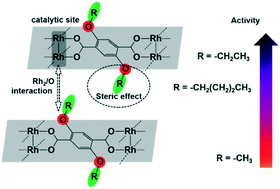Novel dirhodium coordination polymers: the impact of side chains on cyclopropanation†
Abstract
Seven novel dirhodium coordination polymers (Rh2–Ln) (n = 1–7) are prepared by employing bitopic ligands to connect dirhodium nodes. The formation of the framework is confirmed by attenuated total reflectance Fourier transform infrared (ATR-FTIR) and 1H → 13C cross polarization magic angle spinning nuclear magnetic resonance (CP MAS NMR) spectroscopy. Defect sites resulting from incomplete ligand substitution are revealed by 19F MAS NMR. The random stacking behavior of the frameworks in the obtained solid is analyzed by scanning electron microscopy (SEM) and X-ray diffraction (XRD). The Rh2/O interaction in neighboring layers is investigated by diffuse reflectance ultra-violet visible light (DR-UV-vis) spectroscopy and X-ray photoelectron spectroscopy (XPS). This interaction is relevant to understand the catalytic behavior of various Rh2–Ln catalysts in the cyclopropanation of styrene with ethyl diazoacetate (EDA). In this context, the structure-reactivity relationship is discussed by taking into consideration both interlayer Rh2/O interactions and steric effects of side chains.



 Please wait while we load your content...
Please wait while we load your content...